If you’re considering getting a Bengal cat as a pet, the average size of this breed is an important factor to take into consideration. While some Bengals are large in size, many have more compact and muscular builds. This can help you decide if a Bengal cat is right for your lifestyle and home environment.
We’ll be discussing what constitutes an average-sized Bengal from height and weight averages to body characteristics so that you can decide if this type of feline will work best for your situation.
Facts About the Bengal Cat
The Bengal is a domestic cat breed that has been developed to look like wild cats such as leopards, ocelots, and lynxes.
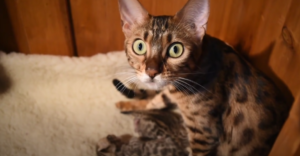
Bengals come in a variety of colours including seal sepia, silver, and brown. The International Cat Association (TICA) recognizes the Bengal as a distinct breed for show purposes.
Bengal Cat Size and Growth
Bengal cats usually weigh 8-15 pounds and are fully grown by age 3. They have strong, compact bodies and lean muscles. Bengals are about the same size as Maine Coons and Ragdolls. They are 10-14 inches long, plus an extra 6-8 inches for their tail.
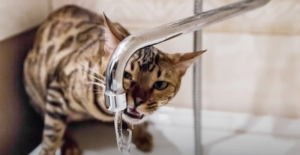
Their average shoulder height is around 9-10 inches, but some may be as tall as 12 inches. Bengals typically have a square head with round eyes and full cheeks. Their coat features a spotted or marbled pattern and is usually short to medium in length.
Is a Bengal Cat a Large Breed?
When compared to other common domestic cat breeds, Bengals are considered a larger breed.
Some Bengal cats can even reach up to 20 pounds in size!
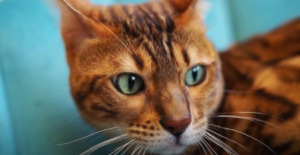
It’s important to remember that there is no one-size-fits-all answer when it comes to average Bengal cat size. While the breed does have a standard size, individual cats may be smaller or larger than the average depending on their parents and genetics. [1]
When Does a Bengal Cat Stop Growing?
Most Bengals are fully grown by 3 years of age, although some may continue to grow until they are 4 or 5. If you adopt a kitten, you can expect them to reach their full size within 3 years. It’s important to keep in mind that male Bengal cats tend to be larger than females.
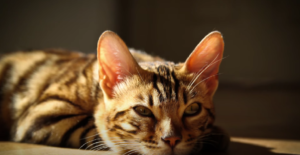
When Do I Know My Bengal Has Reached Maturity?
While Bengals reach their full height and weight by 3 years of age, they are not considered fully mature until 5 years old. This is because it takes that long for them to develop their personality and other characteristics of adulthood.
Factors Affecting the Size of Bengals
The size of a Bengal cat may be affected by several factors, such as genetics, health, and diet. If you’re looking to get a specific-sized Bengal, it’s important to research the parents of your potential pet.
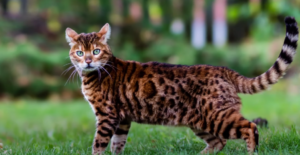
Also, make sure you are feeding them a balanced diet with plenty of vitamins and minerals for optimal growth.
How to Manage a Cat the Size of a Bengal
If you have a Bengal, the size of your cat can affect how you manage them. Because they are larger cats, it is important to provide plenty of space for them to move around and explore.
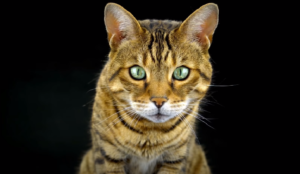
If you live in an apartment or other small living space, make sure that all furniture is secured to the wall so they don’t knock it over.
Is a Bengal Cat Right for You?
The average size of a Bengal cat is an important factor to consider when deciding if this breed is right for you.
If you’re looking for a companion with an exotic wild cat look, a Bengal may be the perfect fit!
Are Bengal Cats Bigger Than Normal Cats?
Bengal cats are generally larger than other common domestic cat breeds. While Bengals typically weigh 8-15 pounds, some can reach up to 20 pounds in size.
[2]Bengal Cat Compared to Normal Cat
When it comes to the size of a Bengal cat compared to other domestic cats, it is important to remember that there is no one-size-fits-all answer.
Bengals are usually larger than popular short-haired breeds like the Siamese or Persian but smaller than the Maine Coon or Ragdoll. Still, some individual cats may be smaller or larger than the average depending on their parents and genetics.
When deciding if a Bengal cat is right for you, it is important to take into consideration its size and the resources available to care for them. If you’re looking for an exotic wild cat look in a larger-sized feline, then a Bengal may be the perfect pet!
FAQ
Are Bengal cats bigger than normal cats?
Bengal cats generally tend to be larger than other common domestic cat breeds. While Bengals typically weigh 8-15 pounds, some can reach up to 20 pounds in size. They have strong and compact bodies with round eyes and full cheeks.
When do Bengal cats stop growing?
Most Bengals are fully grown by 3 years of age, although some may continue to grow until they are 4 or 5.
If you adopt a kitten, you can expect them to reach their full size within 3 years. It’s important to keep in mind that male Bengal cats tend to be larger than females.
When do Bengal cats reach maturity?
While Bengals reach their full height and weight by 3 years of age, they are not considered fully mature until 5 years old. This is because it takes that long for them to develop their personality and other characteristics of adulthood.
Are Bengal cats good pets?
Bengal cats can make great pets if they are provided with the right care and resources. They like to explore and require lots of space, so they may not be a good fit for small living spaces. However, they are known to be loyal and affectionate with their owners. Bengals also tend to have a wild look about them which can add a unique aesthetic to your home.
How big is a Bengal cat in CM?
Bengals typically measure around 25-36 cm in length, not including their tail. Their average shoulder height is 22-25 cm, but some may be as tall as 30 cm.
Bengals typically have a square head with round eyes and full cheeks. Their coat features a spotted or marbled pattern and is usually short to medium in length.
At what age are Bengal cats full-grown?
Most Bengals are fully grown by 3 years of age, although some may continue to grow until they are 4 or 5.
If you adopt a kitten, you can expect them to reach their full size within 3 years. It’s important to keep in mind that male Bengal cats tend to be larger than females.
How much does a large Bengal cat weigh?
Bengals typically weigh 8-15 pounds, though some can reach up to 20 pounds in size. Males tend to be larger than females and have a more muscular look. It’s important to remember that there is no one-size-fits-all answer when it comes to the average weight of a Bengal cat.
How long do Bengals live?
The average lifespan of a Bengal cat is between 12 and 14 years. However, some cats may live longer if they are provided with proper nutrition and veterinary care. Keeping your Bengal indoors can also help them to avoid diseases and injuries that could shorten their lifespan.
How smart is a Bengal cat?
Bengals are known to be very smart cats, often learning new tricks and tasks quickly. They are active cats that need lots of stimulation and exercise to stay mentally healthy.
Bengal cats love toys and can even learn how to play fetch! Providing your cat with plenty of mental stimulation will help them to stay sharp throughout their life.
What Are the Benefits of Owning a Bengal Cat?
Bengal cats are known for their playful personalities and loyalty to their owners. They can be great companion animals if they are provided with enough space to explore and play. Bengals also have an exotic wild cat look that adds a unique aesthetic to any home. Finally, Bengals are known for being intelligent cats that learn quickly and can even be taught how to play fetch. Owning a Bengal cat can bring joy and companionship into your life!
What Are the Drawbacks of Owning a Bengal Cat?
While Bengals can be great pets, there are some drawbacks to owning one. First, Bengals require lots of mental stimulation and exercise to stay healthy and happy. Second, Bengals tend to be larger than other domestic cats and may not fit well in small living spaces.
Finally, Bengals are known for being very vocal cats so if you’re looking for a quiet pet, this may not be the best breed for you. Despite these drawbacks, many people find that the loyalty and companionship of owning a Bengal cat outweighs any negatives.
What Types of Food Should You Feed a Bengal Cat?
It is important to feed your Bengal cat a high-quality diet to keep them healthy and happy. Look for food that has been formulated specifically for cats, with a focus on protein as the main ingredient.
Avoid foods that are filled with fillers or grains, as these can lead to health issues in cats. Make sure to talk to your veterinarian about the best diet for your Bengal cat.
What Is the Average Life Expectancy of a Bengal Cat?
The average lifespan of a Bengal cat is between 12 and 14 years. However, some cats may live longer if they are provided with proper nutrition and veterinary care.
Keeping your Bengal indoors can also help them to avoid diseases and injuries that could shorten their lifespan. With adequate care, you can expect your Bengal to be an active and loyal companion for many years to come.
What Is the Best Way to Care for a Bengal Cat?
Caring for a Bengal cat is similar to caring for any other domestic cat, with some important exceptions. Bengals love to explore and need lots of space, so make sure they have plenty of room to run and play. Make sure you provide them with lots of stimulation, such as toys and activities.
Bengals also need a high-quality diet and regular veterinary care in order to stay healthy. Providing your Bengal with the best possible care will ensure they live a long and happy life with you.
How Do I Know If a Bengal Cat Is Right for Me?
Bengals can be great companion animals if they are provided with the right care and resources. However, they may not be a good fit for small living spaces or people who don’t want to spend time playing and interacting with their cat.
It is important to consider your lifestyle and how much time you can devote to caring for a Bengal cat. If you think a Bengal might be right for you, talk to an experienced breeder and ask questions about the breed before making a commitment.
How Much Does It Cost to Own a Bengal Cat?
The cost of owning a Bengal cat can vary depending on where you purchase your pet and what type of care they need. In general, you should expect to pay anywhere from $500-$1000 for a quality Bengal kitten.
Additionally, you will need to factor in the costs of regular veterinary check-ups, food, toys, and any other supplies your Bengal might need. Taking proper care of a Bengal can be expensive, but the companionship they provide makes it worth the investment.
How Can I Train a Bengal Cat?
Bengals are known to be very intelligent cats, and they can often learn tricks quickly. It is important to start training your cat at an early age, as kittens tend to be more receptive to new tasks. To train your Bengal, use positive reinforcement techniques such as treats or verbal praise when they do something correctly.
You may also find it helpful to take them to an obedience class or hire a professional trainer for more advanced tasks. With patience and practice, your Bengal can learn many new skills.
How Can I Make Sure My Bengal Cat Is Healthy?
Providing your Bengal cat with proper nutrition and regular veterinary care is the best way to ensure they remain healthy. Feed them a high-quality diet, making sure it is specifically formulated for cats and is free of grains and fillers.
Additionally, make sure to keep up with their vaccinations and parasite prevention as recommended by your veterinarian. Finally, provide your Bengal with plenty of mental stimulation and exercise to keep them active and engaged.
How Do I Know If My Bengal Cat Is Happy?
You can tell a lot about your cat’s happiness by observing their behaviour. Bengals that are happy tend to be active and playful, often following their owners around the house or wanting to explore new areas. They may also display affectionate behaviours such as purring and head rubs.
If you notice your Bengal becoming more lethargic or uninterested in their usual activities, make sure to take them to the vet for a check-up. Providing your Bengal with plenty of love and attention is the best way to ensure they are happy and healthy!
Why Should I Consider Owning a Bengal Cat?
Owning a Bengal cat can be a rewarding experience for many people. Not only are Bengals beautiful and exotic-looking cats, they are also very intelligent and loyal companions.
They require plenty of mental stimulation and exercise to stay healthy and happy, but the rewards that come with owning a Bengal cat make it all worth it! If you’re looking for a unique and loving pet, a Bengal cat may be the perfect choice for you.
Why Are Bengal Cats So Expensive?
Bengals are a rare and unique breed of cat, so they can often be more expensive than other domestic cats. Additionally, Bengals require more time and effort to care for properly, which can add to the cost.
Finally, finding a reputable breeder is essential in making sure you get a high-quality Bengal kitten that will be healthy and happy. All of these factors contribute to why Bengal cats can be more expensive than other breeds.
Why Is It Important to Find a Reputable Breeder When Purchasing a Bengal Cat?
Finding a reputable breeder is essential in making sure you get a quality Bengal kitten that will be healthy and happy. Reputable breeders are knowledgeable about the breed and can provide helpful advice on how to care for your new cat.
They also take steps to ensure their cats have the best nutrition and veterinary care available, which is essential in helping your Bengal live a long and healthy life. Taking the time to find a reputable breeder before you purchase a Bengal cat will help ensure you get the best possible pet.
Which Are the Most Popular Bengal Cat Colors and Patterns?
The most popular Bengal cat colours and patterns are brown, silver, snow, and marble. Brown Bengals typically have a rich golden colour with black markings on their face, legs, and tail.
Silver Bengals often have a greyish-silver base colour with darker stripes or spots. Snow Bengals are white with black or brown markings.
And marble Bengals are a combination of brown and silver that creates a unique marbled pattern. All of these colours and patterns can be found in both Bengal cats and kittens.
Do All Bengal Cats Have Blue Eyes?
No, not all Bengals have blue eyes. While it is common for Bengals to have blue or green eyes, some may also have amber or golden coloured eyes. The eye colour of a Bengal is determined by their coat colour and pattern.
For example, snow Bengals often have blue eyes, while marble Bengals typically have green or golden eyes.
Does a Bengal Cat Shed?
Yes, Bengals do shed. While they may not shed as much as other breeds, it is still important to brush your Bengal regularly to help keep their fur healthy and reduce shedding.
Additionally, you can use a deshedding tool to help remove dead hair from their coat more easily. Keeping up with regular grooming will help keep shedding in check and keep your Bengal looking their best.
Do Bengal Cats Get Along With Other Pets?
Yes, Bengals can get along with other pets depending on the individual cat’s personality. While some Bengals may be more aloof and prefer their own company, others may be more social and enjoy playing with other animals.
If you have other pets in your home, keep a close eye on your Bengal when they are around each other to make sure they are getting along.
Additionally, it can be helpful to provide them with plenty of space and separate areas for each pet so that they all have their own place to retreat to if needed.
Useful Video: The Truth About Bengal Cat Size : What Size Do Bengal Cats Grow To?
Conclusion
To sum up, the average size of a Bengal cat is 10-12 pounds and can be anywhere between 14-22 inches tall. There is great variation among individual animals since they are crossbred cats with an ancestry of domestic and wild cats. Bengals come in many colours such as brown, snow, blue, silver, charcoal, bronze or seal lynx point.
Consider all the information above when looking into getting a Bengal so you have an idea of its size and characteristics. Remember that these cats are known for their intelligence and high energy – if you are looking for a cat to cuddle on the couch this may not be the breed for you!
Bengals need lots of attention, exercise, stimulation and playtime in order to stay healthy and active. If you think that this special breed is for you then go ahead and get one – give them the love and care they need and you’ll surely benefit from having such an intelligent, lively friend around!
References:
- https://petkeen.com/bengal-cat-size-growth-chart/
- https://bengalcatcare.com/what-is-the-average-size-of-a-bengal-cat/





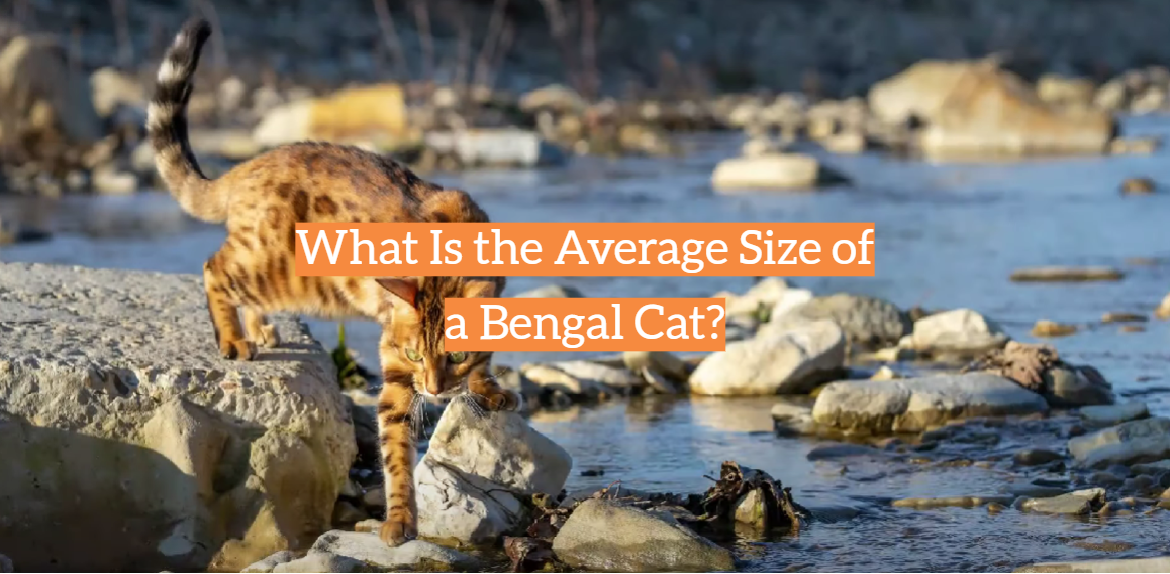



Leave a Reply